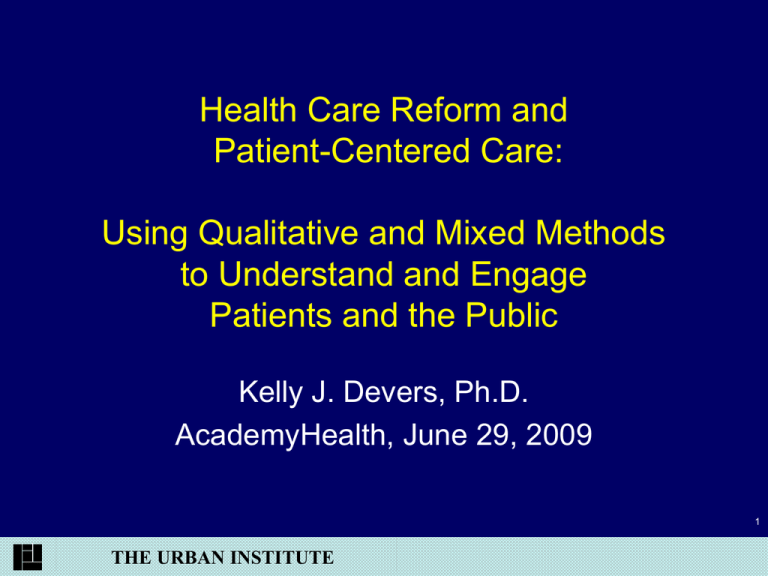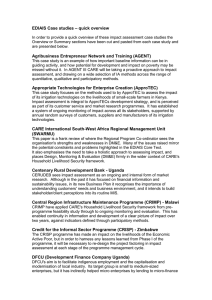Health Care Reform and Patient-Centered Care: Using Qualitative and Mixed Methods
advertisement

Health Care Reform and Patient-Centered Care: Using Qualitative and Mixed Methods to Understand and Engage Patients and the Public Kelly J. Devers, Ph.D. AcademyHealth, June 29, 2009 1 THE URBAN INSTITUTE Panel Focus • Efforts to promote and organize patient, consumer, and/or public involvement to facilitate participation in health care decisions or to inform decisions made by others • Different theoretical/conceptual frameworks, terms, and definitions underlie this work – For simplicity, I use “consumer involvement” throughout this presentation 2 THE URBAN INSTITUTE Potential Benefits of Consumer Involvement (CI) • Policy, research, practice, and patient • • • • information that includes consumers’ ideas or addresses their concerns Improved implementation of research findings Better care Better health Can be viewed as a goal in itself – Encourages participatory democracy, transparency, public accountability, and patient-centered care 3 THE URBAN INSTITUTE CI at Four Levels Health care policy and planning e.g., Reform proposals, technology assessment, incentives to consumers Clinical policies e.g., Clinical practice guidelines Patient information materials e.g., Decision aids Health care research e.g., Priority setting, study design 4 THE URBAN INSTITUTE Barriers to CI • Consumer – e.g., Time, “logistics,” concern about “tokenism” or no real opportunity for input and influence • Professional and/or other stakeholders – e.g., Skepticism about value of “lay input,” desire to control the process and outcome • Practical Challenges – e.g., How to “understand” and “listen” to input from many , may make projects costlier and longer • Evidence base needs to be strengthened 5 THE URBAN INSTITUTE Issues to Consider when Developing CI Initiatives • How is “consumer” defined? – e.g., Individuals, and is so, what kind(s)? Groups, pre-existing or convened for specific purpose? • Degree of CI – Consultative or collaborative • Forum for communication – Consultative (e.g., town meeting, written – consultation, interviews, focus groups) Collaborative (e.g., committee membership, permanent consumer panels) THE URBAN INSTITUTE 6 Issues to Consider (2) • Involvement in decision-making – Implicit (e.g., committee membership) or explicit (e.g., voting, ranking, etc.) • Recruitment of consumers – e.g., Targeted, personal invitations, wide advertisement, mass media, telephone, mail, email, • Training and support – e.g., Introduction day, education, counseling • Financial and practical support – e.g., None, reimbursement for expenses, fee or honoraria, specific funding and staffing THE URBAN INSTITUTE 7 Issues to Consider When Evaluating CI Initiatives • What is the comparison in each domain? • What are the barriers to CI and, perhaps more importantly, how might they be overcome? • Whether and how the impact or outcome of CI is assessed? – If so, by whom? – Using what criteria, methods and data, and measure(s)? 8 THE URBAN INSTITUTE Role of Qualitative and Mixed Methods • Development of CI – CI efforts often use qualitative (e.g., focus groups, interviews) and quantitative methods (e.g., surveys) in novel ways • Evaluation of CI – Implementation • What works, under what conditions? • What doesn’t work, why, ways CI might be improved? – Outcomes • Did the CI achieve its stated aims? • For whom or what does it work more/les well? 9 THE URBAN INSTITUTE http://www.healthreform.gov/reports/hccd/ 10 THE URBAN INSTITUTE Notable Features of Report • Part of broader participatory democracy, transparency, and accountability effort • Method of recruitment – Web, email, friend-to-friend (social network) • Process – In-person discussion groups – Volunteer lay moderator – Suggested topics/questions but groups did not have to follow “protocol” and often did not • “Sample” size – 9,000 people in all 50 states and DC – 3,276 group reports submitted to www.change.gov THE URBAN INSTITUTE 11 Notable Features of Report (2) • Sample size (cont) – 30,603 participant surveys • Rigor and speed of analysis – All 3,276 read line by line, coded and analyzed in – – Atlas.ti by trained volunteers Combined with analysis of survey data and secondary quantitative data Completed in approximately 3-4 months! • How used? – e.g., Presented to and read by President Obama, Distributed at First White House Summit on Health Reform, Shared with all participants and public THE URBAN INSTITUTE 12 Other Presentations • Focus on role of qualitative and mixed methods in developing CIs – Not evaluations • Highlight s a range of qualitative methods – Strengths and challenges – Ways to combine with quantitative methods • Illustrates variation in levels/purpose and way in which methods are used • Evidence-based consumer initiatives! – We need much more research about what works and under what conditions THE URBAN INSTITUTE 13 Speaker Order • Marjorie Ginsburg, Center for Health Care Decisions • Linda Greenberg, AHRQ • Laura Lorenz, Brandeis University 14 THE URBAN INSTITUTE







